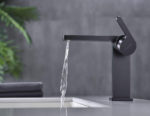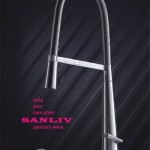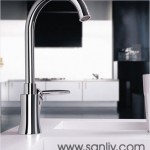1. What types of faucets are there?
Whether you’re buying a faucet for a kitchen, baño, utility sink, tub, or shower, there are many available types.
 | Single-hole faucets are common in kitchens and usually have just a single handle integrated with the same shaft as the spout, though some models have two handles. Como su nombre indica, single-hole faucets mount on sinks, counters, or walls with only one faucet hole, though it is possible to mount a single-hole faucet in a multihole location if you have appropriate hardware to cover the other holes. |
 | Centerset faucets come in one piece, with the spout and handle(s) attached to a molded base. They are commonly used on two- or three-hole bathroom sinks and tubs. |
 | Widespread and mini-widespread faucets come in a variety of traditional and contemporary styles. The two handles and water spout are three separate pieces of hardware designed to mount on three-hole kitchen and bathroom sinks and tubs or showers. |
2. How do I pick the right faucet for my sink, tub, or shower?
Along with finding the style and finish you want, you need to make sure you find a faucet appropriate for the location where you want to install it.
- Paso 1: Choose deck or wall mount. With deck mounts, the faucet is installed on a horizontal surface, such as directly on the sink or tub or on a surrounding counter. With wall mounts, the faucet attaches to shower wall or a wall behind the sink or tub. Wall-mount and deck-mount faucets are not interchangeable–even when they are the same product type, such as a widespread faucet–because their spouts curve differently.
- Paso 2: Examine the installation holes in your sink, ducha, or tub. You must count the number of holes and measure the distance between centers of the outer installation holes. This information will help you know the faucet type you can install on your sink.

A deck or wall with just one hole is easy–it requires a single-hole faucet. 
Three holes 6 inches to 16 pulgadas de distancia usually require widespread faucets, though there are some mini-widespread faucets that can be used where the holes are 6 inches or 8 pulgadas de distancia. You also can use a single-hole faucet mounted on a plate called an escutcheon that covers the unused holes. Side-sprayers and soap dispensers also can fill extra holes. 
Three holes 4 pulgadas de distancia–usually found in bathroom sinks–can accept mini-widespread faucets, some centerset faucets, or single-hole faucets (remember the escutcheon or accessories to cover or fill the other holes). 
Two-holes 4 pulgadas de distancia require a 4-inch centerset faucet. 
Sinks with four or five holes are very common in kitchens, with the extra holes used for sprayers or soap dispenser. But make sure only to measure the distance between the three main faucet holes when determining which faucet type to purchase.
- Paso 3: Pick a suitable spout height and reach. While standard lavatory and sink spouts generally measure from 3 a 6 pulgadas de altura, high-arc spouts measure from 6 a 10 inches or more for washing large items, such as pots in a kitchen sink. The spout always should reach outward far enough to direct water to the center of the sink.
3. What are the cool faucet features and accessories?
Consider some of these timeless or more recent enhancements when shopping for faucets.
- Pull-down sprayers slide out of kitchen spouts to make hosing down dishes easy.
- Soap dispensers require their own hole but keep those unsightly soap bottles off the counter.
- Integrated water filtration systems can help remove chemicals and impurities from your tap water.
- Instant hot-water taps keep tea-water at the ready.
- Temperature-control faucets let you set water temperature so that every time you turn on the bath water it automatically adjusts to the perfect temperature.
- Scald protection helps prevent accidental burns from water that’s too hot–a great feature for families with children.
- Motion-sensor faucets operate without handles, thanks to an electronic sensor that turns on water at just the right temperature when it detects hand-motion. Powered by battery or a hard-wired electric current, they are easy to install, conserve water, and reduce the spread of germs.
4. What do I need for installation?
If you decide to install the faucet yourself, here are some helpful hints.
- Time required for installation is between 20 minutes to 1 hora.
- Instrumentos needed include a flashlight, utility knife, putty knife, adjustable wrenches, and a basin wrench.
- Materiales required include plumber’s putty or silicone caulk, flexible supply lines, bucket or pan, and rags.
5. How much should I spend on a faucet?
Faucets are no different than any consumer product. They come in a range of prices based on their styles, materials, finishes, and features, and only you know which of those things you’re willing to pay more for. Remember that a faucet becomes an essential part of your kitchen or bath décor. You want it to be pleasing to your eye and match the other hardware in the room while providing the functionality you need and meeting the rigors of daily use. Other good information to consider when comparing products are the manufacturer’s reputation, the faucet’s warranty, and customer reviews.















